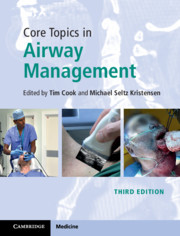Book contents
- Core Topics in Airway Management
- Core Topics in Airway Management
- Copyright page
- Contents
- Contributors
- Foreword
- Preface to the Third Edition
- Section 1 Airway Management: Background and Techniques
- Section 2 Airway Management: Clinical Settings and Subspecialties
- Chapter 22 The Airway in Obstetrics
- Chapter 23 The Paediatric Airway
- Chapter 24 Airway Management in Obesity
- Chapter 25 Maxillofacial and Dental Surgery
- Chapter 26 Ear, Nose and Throat Surgery: Airway Management
- Chapter 27 Lung Separation
- Chapter 28 Airway Management in the Critically Ill
- Chapter 29 The Patient with a Tracheostomy
- Chapter 30 Pre-hospital and Trauma Airway Management
- Chapter 31 Airway Management during CPR
- Chapter 32 The Bloody and Bleeding Airway
- Chapter 33 The Airway in Anaesthesia for Transoral Robotic Surgery
- Section 3 Airway Management: Organisation
- Index
- References
Chapter 23 - The Paediatric Airway
from Section 2 - Airway Management: Clinical Settings and Subspecialties
Published online by Cambridge University Press: 03 October 2020
- Core Topics in Airway Management
- Core Topics in Airway Management
- Copyright page
- Contents
- Contributors
- Foreword
- Preface to the Third Edition
- Section 1 Airway Management: Background and Techniques
- Section 2 Airway Management: Clinical Settings and Subspecialties
- Chapter 22 The Airway in Obstetrics
- Chapter 23 The Paediatric Airway
- Chapter 24 Airway Management in Obesity
- Chapter 25 Maxillofacial and Dental Surgery
- Chapter 26 Ear, Nose and Throat Surgery: Airway Management
- Chapter 27 Lung Separation
- Chapter 28 Airway Management in the Critically Ill
- Chapter 29 The Patient with a Tracheostomy
- Chapter 30 Pre-hospital and Trauma Airway Management
- Chapter 31 Airway Management during CPR
- Chapter 32 The Bloody and Bleeding Airway
- Chapter 33 The Airway in Anaesthesia for Transoral Robotic Surgery
- Section 3 Airway Management: Organisation
- Index
- References
Summary
Paediatric anaesthesia and airway management is in many ways similar to adult practice; however, deep understanding of the differences in anatomy, physiology and behavioural psychology is necessary, particularly in younger children and infants. This chapter aims to provide the anaesthetist with information on these differences and (re)introduce techniques and practical tips that may help practitioners with airway management in this population. The broad range of equipment sizes and drug doses are a challenge to memorise and guides are highly advised. While difficult airways are less frequent in children, their management can be challenging. Upper airway obstruction is a particularly frequent occurrence, and should be anticipated and prevented, focussing on basic, and much underappreciated, skills such as positioning, effective bag-mask ventilation and occasional careful use of adjuncts. Safe and non-traumatic practice is key. It is important to stress that modern devices such as videolaryngoscopes should be used carefully and under visual guidance at all times. Awake flexible optical bronchoscope (FOB)-guided intubation is the gold standard in adult difficult airway management. In paediatric practice, however, advanced airway procedures may need to be performed with prior general anaesthesia. We offer an introduction to some advanced techniques including paediatric emergency front of neck airway.
Keywords
- Type
- Chapter
- Information
- Core Topics in Airway Management , pp. 192 - 205Publisher: Cambridge University PressPrint publication year: 2020



